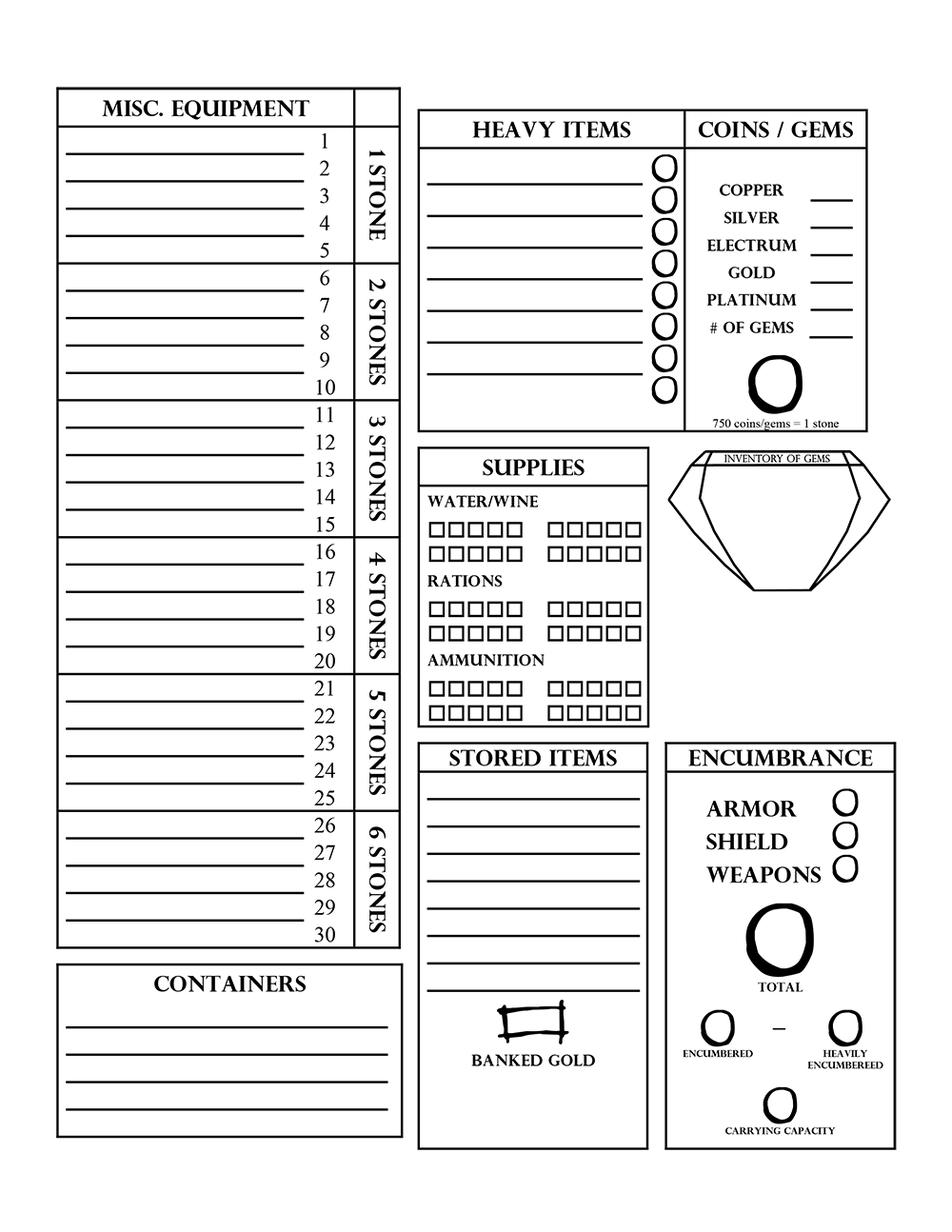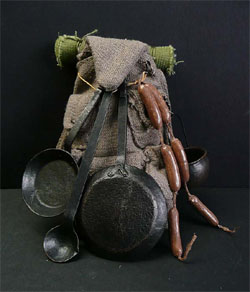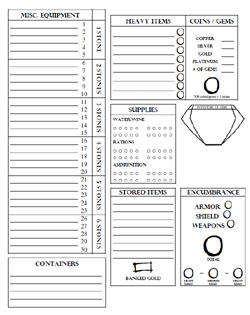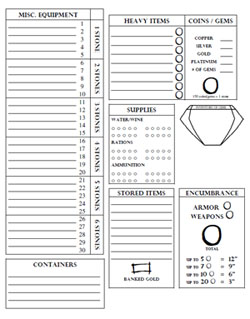Where the encumbrance by stone system really comes alive is the equipment sheet, which basically makes tracking encumbrance as easy as listing what you’re carrying.
Encumbrance Rule: You can write down your character’s encumbrance rule (based on their Strength score) in the spaces provided in the lower right corner.
Armor/Shield/Weapons: The assumption is that your currently equipped armor, shield, and weapons will be listed for reference on the front of your character sheet. You can jot down the current encumbrance value for these items in the spaces provided in the lower right hand corner of the sheet.
Coins/Gems: These are listed in the upper right and their encumbrance is calculated as shown. (To quench the “I have one coin and it apparently weighs a ton” complaints, you can allow PCs carrying 20 or fewer coins to list them as “loose change” in the miscellaneous equipment section.)
Heavy Items: This section is for listing anything that qualifies as a heavy item (i.e., weighs 1 or more stones all by itself).
Miscellaneous Items: This column is the heart of the sheet. Simply list everything you’re carrying in bundles of 20 or less. When you’re done, you can immediately see how many stones of miscellaneous equipment you’re carrying. Bam.
Add Misc. Equipment + Heavy Items + Coins/Gems + Armor/Shield/Weapons to determine your Total Encumbrance. In practice, this is all single digit arithmetic and adjusting your encumbrance on-the-fly during an adventure is practically automatic.
Moving equipment to your horse? Picked up a bunch of treasure? Throwing away your shield in order to run away from the goblin horde at your heels? It can all be done in seconds.
TIPS & TRICKS
Stored Items: This section of the sheet is for anything you own that isn’t currently being carried by your character.
Inventory of Gems: The specific value of gems are tracked separately to make calculating coin/gem encumbrance easier.
Containers: This area is used for listing containers in use (which don’t count against encumbrance). Empty containers should be listed as miscellaneous equipment. There are two easy methods for tracking which items are in which container:
- List miscellaneous equipment slot numbers next to the container.
- Put a symbol (star, circle, square, etc.) next to the container, then mark items in the container with the same symbol.
Tracking Supplies: The intention is that you list your supplies in the miscellaneous equipment section, but you can quickly check off supplies used on the trackers. At some point of convenience, you can go through your equipment list, adjust the totals, and then erase the supply checklists to start anew.
The Blank Space: After making the sheet I kept expecting something to crop up that I’d forgotten. (At which point I’d have this convenient blank space to slot it into.) After a several years, nobody has suggested anything. (Let me know if you think of something.)
DESIGN NOTES
The goal of the encumbrance by stone system is to simplify the encumbrance rules to the point where:
- It is virtually effortless to track encumbrance and, therefore,
- The rules can be used to meaningful effect on-the-fly during actual gameplay.
All the way back in 1974, this type of gameplay was discussed. In Volume 3: The Underworld & Wilderness Adventures, for example, we can read:
If the adventurers choose to flee, the monster will continue to pursue in a straight line as long as there is not more than 90 feet between the two. (…) Distance will open or close dependent upon the relative speeds of the two parties, men according to their encumbrance and monsters according to the speed given on the Monster Table in Volume II. In order to move faster characters may elect to discard items such as treasure, weapons, shields, etc. in order to lighten encumbrance.
But in actual practice the encumbrance rules were such a pain in the ass — and have remained such a pain in the ass — that either (a) they’re not used at all or (b) the amount of calculation required to adjust your encumbrance is sufficiently onerous that no one is going to try to do it in the middle of a chase scene.
When I started using the encumbrance by stone system, however, I almost immediately saw explicit encumbrance-based play crop up in actual play. And although “encumbrance-based play” may not sound all that exciting at first glance, being forced to throw away your favorite shield or abandon several weeks worth of rations on the pack horse actually creates really cool moments! (Going back for your shield, for example, can be a unique motivator. Running out of food because you had to leave the rations behind can throw your plans completely out of whack and force you to start improvising.)
My experience has been that, once you have a fully functional encumbrance system, you’ll wonder how you ever lived without it. Encumbrance certainly isn’t essential to every adventure, but it is particularly vital for expedition-based play: It is a budget you are spending to prepare for the expedition and it is also frequently the limit on the rewards you can bring back. The desire to manage and expand your encumbrance limits for an expedition (by using mounts, pack animals, and/or hirelings) will frequently unlock unique gameplay and storytelling opportunities.
Running expedition-based play without encumbrance is like running combat without keeping track of hit points. The encumbrance by stone just makes it easy to do what you need to do.
THINKING ABOUT STONES
Roughly speaking, for the purposes of estimating the stone weight of larger items, you can assume that a stone is equal to 15 lbs. in 5th Edition.
Thinking about the “value” of a stone in such concrete terms, however, is to largely miss the point of the system: The stone is deliberately chosen as an obscure unit of measurement whose definition is intentionally vague. The stone is not defined as a specific weight; it exists in a nebulous range, but probably somewhere between 10 and 20 pounds most of the time.
This is based on historical fact: Although eventually set by British law at 14 pounds, the stone historically varied depending on the commodity being traded and the location in which it was being traded. (For example, the 1772 edition of the Encyclopedia Britannica states that a stone of beef was eight pounds in London, twelve pounds in Hertfordshire, and sixteen pounds in Scotland.) This makes it fairly ideal to provide a system which uses crude approximation in an effort to vastly simplify the bookkeeping involved with tracking encumbrance. And the slightly archaic nature of the terminology is also immersive for a fantasy world. (“I’m carrying about eight stone.”)
“But I’m British!”
The British still commonly use stones to measure body weight. And I’ve heard from some, but not all, that this makes it too difficult to slip into the medieval/Renaissance mindset where weights are relative and often imprecise.
If you find that to be the case for yourself, I recommend just swapping out the term “stone” for something else. You can go for something generic like “slots,” although you lose the immersive quality of the system (where both you and your character think of their load in similar terms). Another option would be a purely fictional term. For example, you might reframe the system using dwarven daliks.
SPECIAL THANKS
The design of this system was originally inspired by Delta’s D&D Hotspot and Lamentations of the Flame Princess.
















